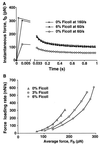Selectin receptor-ligand bonds: Formation limited by shear rate and dissociation governed by the Bell model
- PMID: 11158576
- PMCID: PMC14690
- DOI: 10.1073/pnas.98.3.950
Selectin receptor-ligand bonds: Formation limited by shear rate and dissociation governed by the Bell model
Abstract
We have studied the principles that govern the formation and dissociation of an adhesive bond between a cell moving in shear flow and a substrate and tested different theories of how force affects bond dissociation. Viscosity relates the kinematics of fluid movement (shear rate, units of time(-1)) to shear stress (units of force/area, the product of shear rate and viscosity). At different medium viscosities, the formation of receptor-ligand bonds between a cell in the flowstream and P-selectin on the vessel wall showed a similar efficiency as a function of shear rate but not of shear stress. Therefore, bond formation was a function of shear rate and hence of the kinematics of receptor and ligand movement. By contrast, the kinetics of bond dissociation was a function of shear stress and hence of force on the bond. The different requirements for bond formation and dissociation allowed dissociation kinetics to be measured at higher forces on the bond by increasing medium viscosity. Data over an extended range of forces on the bond therefore could be collected that enabled five different proposed equations, relating force to bond dissociation, to be compared for fit to experimental data. The relationship proposed by Bell [Bell, G. I. (1978) Science 200, 618-627] fit the data significantly the best and also predicted an off-rate in the absence of force that best matched an independent measurement [Mehta, P., Cummings, R. D. & McEver, R. P. (1998) J. Biol. Chem. 273, 32506-32513].
Figures





References
-
- Bell G I. Science. 1978;200:618–627. - PubMed
-
- Zhurkov S N. Int J Fract Mech. 1966;1:311–323.
-
- Dembo M, Torney D C, Saxman K, Hammer D. Proc R Soc London Ser B. 1988;234:55–83. - PubMed
-
- Dembo M. In: Some Mathematical Problems in Biology: Lectures on Mathematics in the Life Sciences. Goldstein B, Wofsy C, editors. Vol. 25. Providence, RI: Am. Mathematical Soc.; 1994. pp. 1–27.
Publication types
MeSH terms
Substances
Grants and funding
LinkOut - more resources
Full Text Sources
Other Literature Sources

